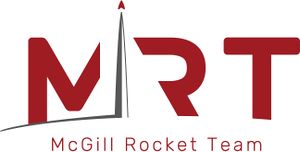Rocket Team
 | |||||||||||||||
| Mission: | To develop a Canadian aerospace community by providing students with practical experience in the development of rocket technologies and by promoting the Canadian aerospace industry. | ||||||||||||||
|---|---|---|---|---|---|---|---|---|---|---|---|---|---|---|---|
| |||||||||||||||
The McGill Rocket Team is an EUS Design Team that aims to develop a Canadian aerospace community by providing students with practical experience in the development of rocket technologies and by promoting the Canadian aerospace industry. In practice, this means that members of the team build sounding rockets for various student rocketry competitions. The main competition the Rocket Team participated had been the Intercollegiate Rocket Engineering Competition (IREC), now called Spaceport America Cup (SAC), but as of 2022, the McGill Rocket Team is planning to compete in the Launch Canada competition. The team, founded in 2014, has grown from 20 members to roughly 150 members, and is among the biggest design teams at McGill University.
Working with the team allows our members to apply the scientific and engineering knowledge taught at McGill University in real-world applications and helps them build the soft skills essential to their future professional lives. Notable events we participate in includes McGill recruitment events, Montreal Space Symposium, and events to promote women in STEM. Being a part of the McGill Rocket Team is unforgettable, from the thrills of a rocket launch to the strong friendships forged through shared experiences.
Contents
Subteams
McGill Rocket Team is split into various subteams; Aerostructures, Recovery, Avionics, Propulsion, Payload, and Logistics. Each sub-team operates as a semi-autonomous entity, with project requirements set by team leadership at the beginning of the design cycle. Students who join the team may engage in many different fields which include composites and structures, fluids, and electronics. Each subteam varies greatly in the projects they do so our rocket can fly. As such, you can definitely find a project that suits your interest on the team.
Aerostructures
Aerostructures is responsible for designing and building the external airframe and internal structure of the rockets. The team performs aerodynamic analysis on the airframe, and load analysis on the internal structures to ensure weight is minimized while still meeting each subsystem's requirements. The team has developed its composites manufacturing techniques, making the whole airframe out of carbon fiber and fiberglass manufactured in house.
Recovery
The Recovery Subteam, as the name suggests, focuses on the recovery of the rocket. Its work focuses on the second half of the flight, from apogee to landing (and then hopefully when the team finds and brings back the rocket). Recovery takes care of the systems linked to the parachutes and their deployment as well as other systems that aim to help retrieve the rocket after touchdown. This includes the ejection systems, the parachute themselves and the recovery harness.
Avionics
Avionics designs a wide array of electrical systems on the rocket and the ground, including but not limited to: rocket telemetry, recovery sequence circuits, and ground communications. Avionics also collaborates heavily with Aerostructures for the design of the avionics bay for the main electronics. The Avionics team converts the rocket from a ballistic composite dart to a safe, recoverable, and re-usable payload delivery system (depending on how well we do our job). The team designs and builds its own integrated circuits, and integrates off-the-shelf components with the circuits.
Payload
Payload is tasked with designing and building a payload that will carry out an experiment during rocket flight, at apogee, or during descent. In general, experiments leverage either the intense accelerations induced by the rocket motor, the apogee the rocket reaches, or the time it spends in the lower atmosphere after parachute deployment. Experiments only have hard weight constraints, with more flexible dimension constraints, and the purpose of the experiment is up to each year's payload team to decide: for example, the 2017-2018 payloads were an atmospheric bacterial sampling experiment and an experiment investigating the effects of high acceleration on small-scale brain models.
Propulsion
Propulsion is primarily responsible for the design, manufacturing and verification of the rocket engine. Secondary responsibilities mostly encompass the testing of the propulsion components at the rocket engine test site located in MacDonald Campus, a new facility that was designed and built by the subteam. Propulsion also produces all the engine related infrastructure such as the engine igniters, the launch rails and the rocket integration components.
Management
Management is responsible for the operation and logistics of team operation. This includes organizing events, managing the team's social media, contacting sponsors, and planning outreach efforts.